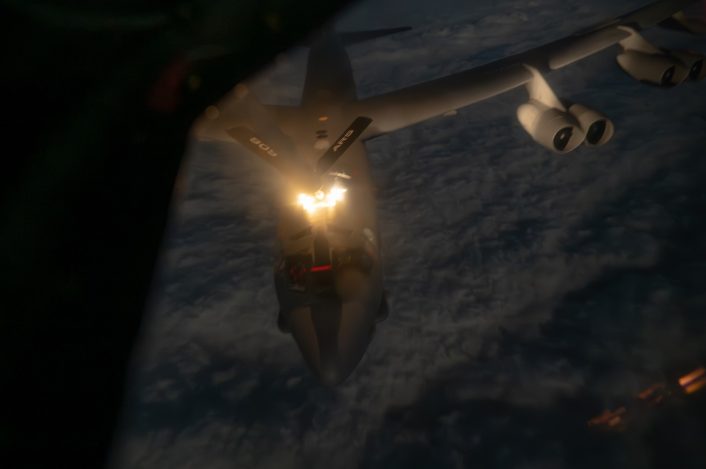The bilateral exercise, which included formation flight and Defensive Counter Air training, was held following “intensified activities concerning Japan’s national security,” possibly referring to the recent Russian and Chinese bomber flights in the area.
The Japan Ministry of Defense (MoD) revealed a massive aerial drill it undertook with the United States on Dec. 16, 2024, which comprised 35 aircraft including F-15s, a B-52H Stratofortress bomber, F-35As, F/A-18s, F-22s, F-16s and E/A-18G Growler electronic warfare jets. The maneuver was a part of a bilateral exercise in the airspace over the Sea of Japan, East China Sea and West Pacific Ocean.
While large formations of American and Japanese combat aircraft have flown before, such a large number has not been witnessed prior to this, possibly making it one of the biggest Allied air exercises seen in recent times, in terms of the number of participating aircraft. However, officially released pictures by the Japan MoD showed only F-15Js from the Japan Air Self-Defense Force (JASDF) and a B-52 bomber. There were no pictures or official statements from the U.S. side at the time of filing this report.
The MoD said the exercise was conducted “amid an increasingly severe security environment surrounding Japan following intensified activities concerning Japan’s national security.” While not specified, this statement could be referred to the recently increased Russian and Chinese bomber activity in the area, including the first patrol near Japan of the latest variant of the Chinese H-6 bomber, the H-6N.
The MoD also said the exercise “reaffirms the strong intention between Japan and the United States to not tolerate the unilateral changes to the status quo by force.” Moreover, the exercise “further strengthens deterrence and response capabilities of the Japan-U.S. Alliance.”
【Japan-U.S. Bilateral Exercise】
JSDF and U.S. Forces conducted a bilateral exercise amid an increasingly severe security environment surrounding Japan following intensified activities concerning Japan’s national security. pic.twitter.com/ivcmziFMg9
— Japan Joint Staff (@JapanJointStaff) December 17, 2024
The exercise
The press release by the Joint Staff described the exercise as a mix of formation flying and tactical drills, with the latter including Defensive Counter Air training. The JASDF sent 13 F-15Js, of which three each were from the 5th and 6th Air Wings at Nyutabaru and Komatsu air bases, and seven were assigned to the 9th Air Wing at Naha air base.
The lone B-52H Stratofortress (Air Force serial 61-0018) is assigned to the 5th Bomb Wing at Minot Air Force Base, North Dakota. Of the 13 F-15Js, the pictures released by the Japan MoD show the bomber accompanied by six different F-15Js, two from each unit.
Meanwhile, the composition of the U.S. fleet, beside the B-52, included four F-35As, four F/A-18s, four F-22 Raptors, six F-16s and three E/A-18G Growlers. No pictures capturing the rest of these jets were released either by the U.S. or the Japanese side.
Based on the current deployments of U.S. air assets in the Indo-Pacific region and under the ambit of the U.S. Forces Japan, it is likely that the F-35s and F-22s were the ones currently deployed to Kadena air base, while the F/A-18s and E/A-18Gs belong to the Carrier Air Wing-5 (CVW-5) forward based at Marine Corps Air Station (MCAS) Iwakuni.
A previous instance where U.S. and Japanese aircraft trained together was during the biennial Keen Sword exercise in October 2024. This saw JASDF F-2s (the Japanese heavily modified F-16 variant) flying with assets of the 77th Expeditionary Fighter Generation Squadron at Tsuiki Air Base. However, it is unclear if the latest exercise was a planned drill, as it appears to be in response to military moves by strategic rivals Russia and China in the western Pacific and far east Asia.
On Nov. 3, 2024, 11 U.S., Japanese and South Korean aircraft were involved in a trilateral exercise that involved escorting a U.S. bomber. The official image released on that occasion showed a single B-1B Lancer bomber, along with four Republic of Korea Air Force (ROKAF) F-15K Slam Eagles, four JASDF F-2s and two U.S. Air Force F-16s.
Russian-Chinese strategic bomber drill
The U.S. and Japanese drill followed Russian and Chinese maneuvers where both air forces sent their nuclear capable strategic bombers to the Sea of Japan, the East China Sea and the waters east of the First Island Chain on Nov. 29, 2024. The Russian Ministry of Defense said on Nov. 30 that Tu-95MS and PLA Air Force H-6K “carried out air patrols over the waters of the Sea of Japan, the East China Sea, and the western part of the Pacific Ocean.”
The flight lasted eight hours, according to the reports. Chinese J-16 and Russian Su-30SM and MiG-31 jets were also present and the formation was “escorted by fighter jets of foreign states at certain stages.” As per reports, this was the ninth joint aerial patrol between the two countries since 2019. A video released after the patrol showed a JASDF F-15J being recorded from inside the Tu-95MS.
A J-16 fighter jet escorted an H-6N bomber and a Tu-95 bomber during the 9th China-Russia joint strategic air patrol in relevant airspace over the Sea of Japan on Friday, marking the first time the H-6N has made a patrol debut: PLA media China Bugle https://t.co/LFEEIYDFY2 pic.twitter.com/B10YwjBLrp
— Global Times (@globaltimesnews) November 29, 2024
However, as reported by The Aviationist, the H-6 bomber was not the H-6K, as stated by the Russians, but it was the nuclear-capable H-6N variant. In fact, the H-6N was immediately recognizable in other videos from Chinese state media thanks to air refueling probe introduced by the new variant and the bomb bay replaced by a semi-recessed area with attachment points for air-launched ballistic missiles.










